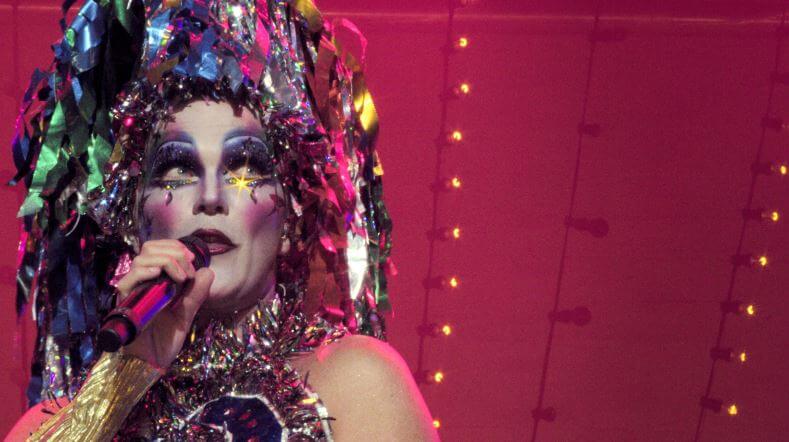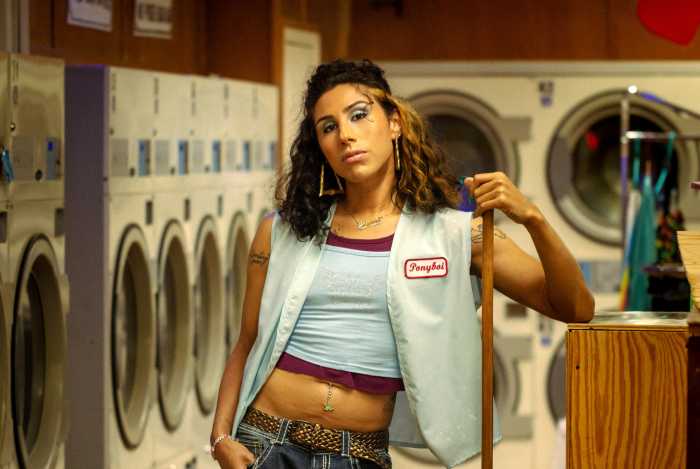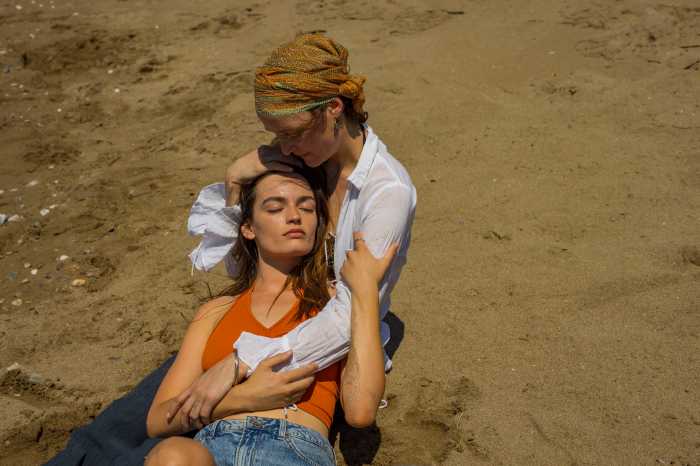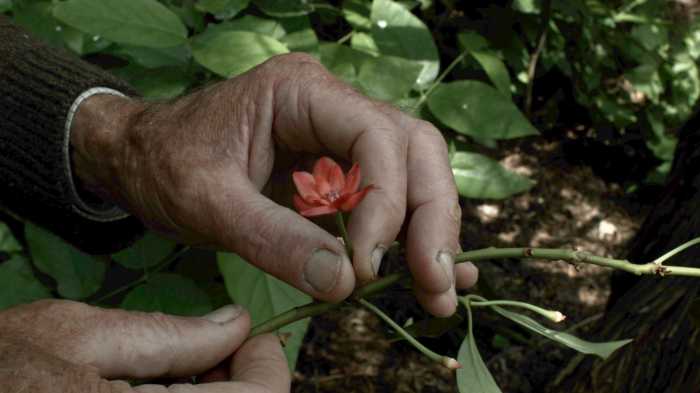Taylor Mac’s “A 24-Decade History of Popular Music,” directed by Rob Epstein and Jeffrey Friedman, documents the extraordinary and ingenious 2016 titular event at St. Anne’s Warehouse, in Brooklyn. This maximalist “performance art concert” chronicles American culture through songs, storytelling, and audience participation, with Mac staging a battle between Stephen Foster and Walt Whitman, reappropriating the racism in songs like “Ghosts of Uncle Tom,” and turning Ted Nugent’s homophobic “Snakeskin Cowboy” into a gay junior high prom for the audience. He also removes one of his 24 stage musicians every hour, signifying the painful losses suffered during the AIDS crisis. His imaginative costumer, Machine Dazzle, designs multilayered, eye-popping creations using corks, toilet paper rolls, and even potato chip bags, that have to be seen to be believed. But it is Mac’s unwavering voice — as well as his endurance — that makes this performance so inspiring. Epstein and Friedman’s documentary will have viewers wishing they had attended in person, and grateful to get a glimpse of what was truly a phenomenal production.
The filmmakers spoke with Gay City news about their documentary “Taylor Mac’s A 24-Decade History of Popular Music.”
Your films celebrate queer life and culture. Why did you select this very specific performance as a subject to document?
Jeffrey Friedman: We were huge fans of Taylor’s before this event. We’ve seen his work over the years. It feels like our work and his work are very aligned in a way. We’re both interested in history and in queer history. Taylor’s way of dealing with that history is so unique and so beautifully inclusive, it seemed like a wonderful opportunity to help translate it to a medium that would reach a lot more people.
How did you get Taylor to entrust you to make this film and what was collaborating with him like?
Rob Epstein: Taylor would have to answer why, but he said our previous films were meaningful and important to him, so he was aware of us as filmmakers. We were very happy to get the call when they decided they wanted to make a film out of the show. They had already captured the live performance but had not done anything with the material. They brought us on to figure out how to make a movie out of this wealth of performance footage. They shot it back in 2016 and 2017. We came on and looked at all the material and figured out how to tell the backstory of the creation of show and did our own round of production with Taylor and his creative team, which are the photo shoot and interviews in the film.
What decisions did you make about what to show and what to cut?
Jeffrey Friedman: We had to make hard choices, but you have to do that with every film. Our goal was to create a version of a 24-hour event that people could experience in under two hours. We were looking for the essence — thematic threads that Taylor worked through the 24-hour storyline. Taylor tells lots of stories in the performance, so we looked for parts of those stories that would make sense to an audience in a shorter film. We looked for things that would allow us to create a film narrative.
Rob Epstein: We also wanted to represent the durational aspect of the show — both for the performers and for the audience, so it was a representation of what that 24-hour experience was like.
Jeffrey Friedman: Taylor is telling a 240-year history in 24 hours, so he had to make a lot of choices. We had to make parallel choices to winnow it down.
You feature interviews throughout the documentary, with Mac, with costumer Machine Dazzle to show behind the scenes. How much of the “magic” did — or could — you reveal and why?
Rob Epstein: That’s what a documentary can do, it can take you behind the scenes. We thought that was important; that is not just a concert film, but you have that backstage point of view where you get to see the construction of the costumes, and what went into them, and the meaning behind these elaborate conceptual pieces. The behind the scenes [segments] allowed us to give that context.
Jeffrey Friedman: Talking to Taylor and his collaborators and have them explain their intensions behind the theatrical experience was important. it added another dimension to the experience and allowed us to compress time. We could make jumps in time with the help of contextual interviews and the photo shoot.
Rob Epstein: You also get a sense of their personalities in the behind-the-scenes segments. Taylor and Machine are not in performance mode but who they are as artists in the creation of the characters and costumes they are creating.
You could have approached this as a performance film, like “Stop Making Sense,” which takes place almost entirely on stage. Your film is a concert that goes deeper, showcasing the audience who are participants in this experience. Can you talk about incorporating the viewers and creating a “you-are-there” feeling?
Jeffrey Friedman: So much of Taylor’s work is about the audience. He involves them directly in his art. It’s immersive. The durational aspect was something the audience felt in their bones. We felt it was important to communicate that. He creates community, and that’s something that theater can do that no other medium can do. We wanted to find a way to help a film viewer experience that aspect of Taylor’s work.
Rob Epstein: I love that you referenced “Stop Making Sense” because that was the totem concert film we had in mind when we started working on this film. Just because of its style and visceral scene of performance you get watching that film, we wanted our film to have those qualities and we realized we needed another dimension to our story, which is the behind the scenes, which you don’t get in “Stop Making Sense.”
What observations do you have about how music and queer culture are so intertwined? Mac’s song choices are deliberate, interesting, and even curious. As I watched, I kept processing the song I knew and how he presented it.
Jeffrey Friedman: Taylor and Matt Ray, his music director, chose the songs and as they explain whether they chose them because they liked the song and whether it would illuminate history in a way that they were trying to do in this show. Every song has a purpose in terms of themes and story.
Rob Epstein: That’s the delicious fun of the show and the film, is his reinterpretation of these songs and how he repurposes them and how he reassigns different meanings to them. We open the film with “Gimme Shelter” which in the show Taylor presents in the context of fag bashing. There are so many surprises Taylor’s journey takes the audience on. That was the fun and challenge of the film is to have that work in screen terms in the way Taylor makes it work in theatrical terms. I think of Taylor’s opening line to the show: “Welcome to radical faerie realness ritual.” He sets the template for what the experience is going to be — a queer lensed extravaganza. He makes a ritual we can all participate in. [This] is bringing a straight audience into our queer culture and having them live as if they are in the midst of queer culture.
What is it like to revisit this performance so many years after it happened? Why do you think it remains timely?
Jeffrey Friedman: The show began in 1776. That’s as relevant today as in 2016. It’s looking back at history, so in that sense, it’s timeless. It’s looking at history through a queer lens and from people who don’t ordinarily get to write history. Taylor is reclaiming that history for a lot of groups. Historically, history has been written by straight white men by and large. What Taylor does is present that history from queer perspective and other oppressed groups. People of color. People who have been dispossessed of history for centuries. I don’t think it makes a difference if we are in 2023 or 2016, we are looking back at our history in new way.
Rob Epstein: Taylor is also such a great humanist; it’s his generous humanistic view of the world as he presents this history in new way, it is this overarching history that is so infectious for an audience.
Jeffrey Friedman: It is pure chance that this comes out at a time when Republicans are using drag queens as a fear mongering target. Taylor is a lot more than a drag queen, but he is also a drag queen.
Rob Epstein: I think it’s also an opportunity to show how drag queens are community builders, so I hope that becomes part of the conversation as well.
“Taylor Mac’s A 24-Decade History of Popular Music” | Directed by Rob Epstein and Jeffrey Friedman | On HBO and available to stream on Max.



































